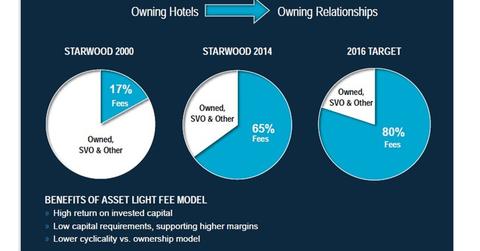Analyzing Starwood’s Asset-Light Strategy
In 2006, Starwood’s management embarked on an asset-light strategy. It decided to sell a significant portion of Starwood’s owned hotel portfolio.
April 9 2015, Updated 6:05 p.m. ET

Asset-light strategy
Historically, Starwood Hotel and Resorts (HOT) derived the majority of its revenue and operating income from its owned, leased, and consolidated joint venture hotels. However, in 2006, Starwood’s management embarked on an asset-light strategy.
It decided to sell a significant portion of Starwood’s owned hotel portfolio. The majority of these hotels were sold subject to long-term management or franchise contracts. Since 2006, Starwood sold 87 hotels. It realized cash proceeds of ~$7.1 billion.
Starwood’s management periodically reviews the business to identify non-core assets that could be sold at significant premiums. As part of the asset-light strategy, the company is focused on reducing its investment in owned real estate, enhancing real estate returns, and monetizing investments.
Spin-off is supporting asset-light strategy
As noted in the 4Q14 earnings call, Starwood is spinning off the vacation ownership business. Starwood’s management expects that the spin-off will likely accelerate its asset-light transformation. It will convert Starwood’s participation in vacation ownership to an asset-light and fee-based business model. The benefits of the asset-light fee model are shown in the above chart.
In 2011, Marriott (MAR) spun off its timeshare segment to Marriott Vacations Worldwide Corporation, or MVW. Other companies in the vacation ownership segment include Hilton’s (HLT) Hilton Grand Vacation, Hyatt’s (H) Hyatt Residence, and Wyndham’s (WYN) Wyndham Vacation Resorts.
ETFs like the PowerShares Dynamic Leisure and Entertainment Portfolio (PEJ), the iShares U.S. Consumer Services (IYC), and the Consumer Discretionary Select Sector SPDR Fund (XLY) provide investors with diversified exposure to these hotel companies.
